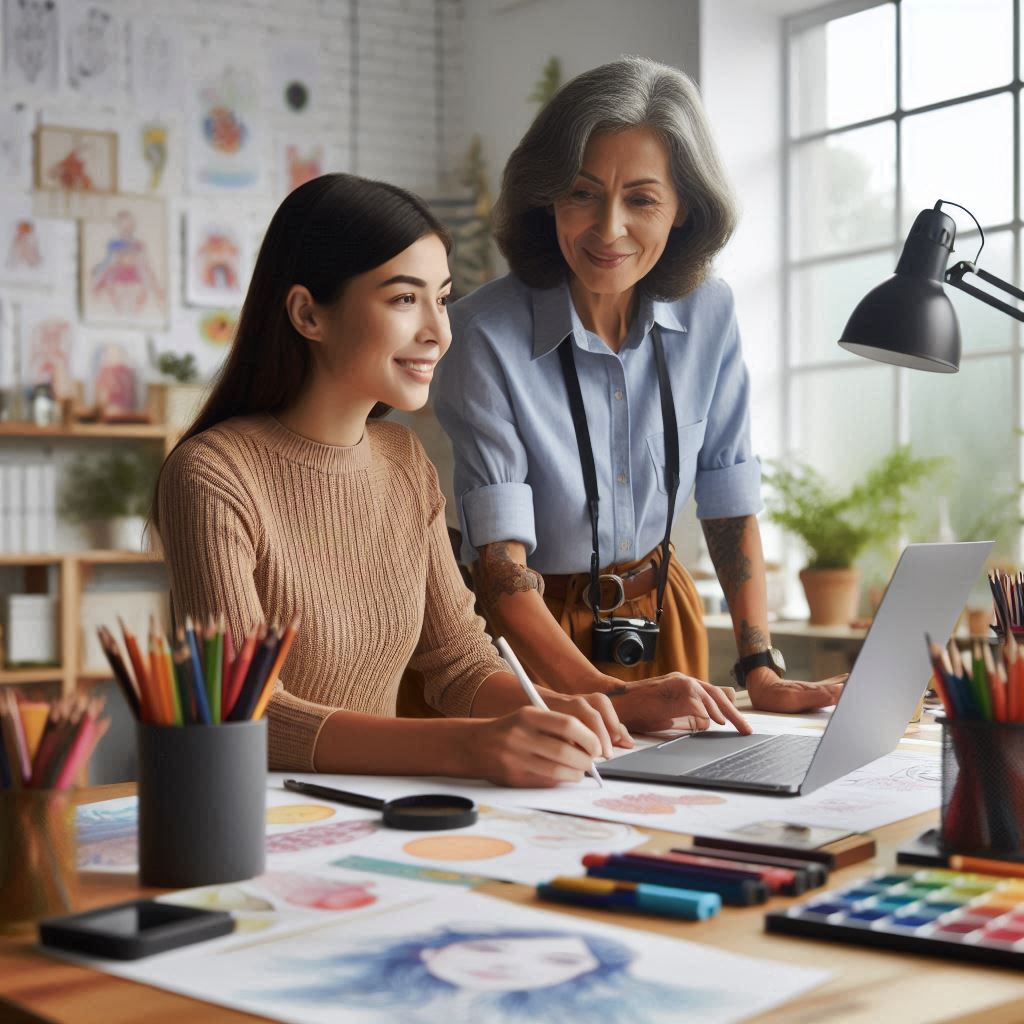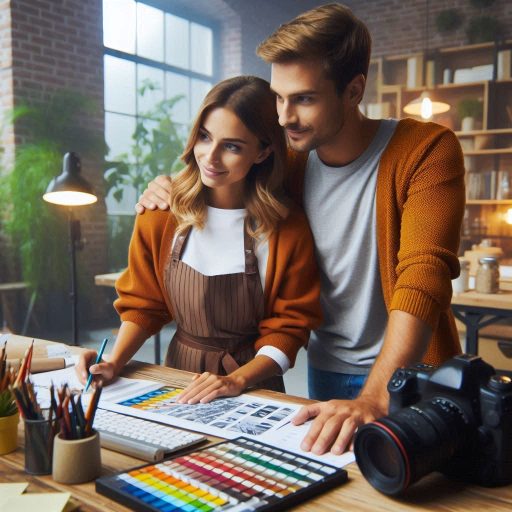Introduction
Finding Your Unique Style in Illustration
Finding your unique style in illustration is essential for standing out in a crowded field.
It involves discovering a visual approach that reflects your individuality and artistic vision.
This journey of self-discovery requires experimenting with different techniques, mediums, and subjects.
As you explore various styles, you’ll start to notice patterns and preferences that resonate with you.
Embrace this process of trial and error to refine your style.
Importance of Having a Unique Style
In the competitive world of illustration, having a unique style is crucial for success.
It distinguishes you from other artists and helps you attract potential clients.
A distinct style not only makes your work memorable but also establishes a strong personal brand.
It allows you to showcase your creativity and express your individuality.
By developing a recognizable style, you increase your chances of securing opportunities and collaborations.
A unique style can lead to higher visibility, as clients and audiences will seek out your specific approach.
It’s not just about aesthetics; it’s about building a lasting impact and creating a space where your work shines.
Understanding the Basics of Illustration
The Importance of Mastering Foundational Skills Such as Drawing, Composition, and Color Theory
Mastering foundational skills is crucial for developing your unique style in illustration.
Drawing, composition, and color theory form the core of effective artwork.
Strong drawing skills allow you to accurately represent ideas and express emotions.
Practice drawing regularly to improve your precision and versatility.
Understanding composition helps you arrange visual elements in a balanced and engaging way.
Good composition directs the viewer’s eye and enhances the overall impact of your artwork.
Additionally, mastering color theory enables you to create harmonious and dynamic color palettes.
Knowledge of color relationships, contrasts, and harmonies can significantly influence the mood and effectiveness of your illustrations.
By solidifying these foundational skills, you build a solid base from which your unique style can emerge and evolve.
The Need to Experiment with Different Techniques and Mediums to Find What Works Best for You
Experimenting with various techniques and mediums is essential for discovering your unique style.
Start by trying different drawing tools, such as pencils, ink, or digital tablets, to see what feels most comfortable.
Explore a range of artistic techniques, including cross-hatching, stippling, and blending, to find methods that resonate with your creative process.
Experimenting with various mediums, like watercolor, acrylics, or digital brushes, allows you to see how different materials affect your work.
Each medium and technique offers unique possibilities and can lead you to new discoveries about your style.
Don’t be afraid to mix and match techniques to create something distinctive.
The more you experiment, the more you learn about what works best for you and your artistic vision.
Mastering foundational skills such as drawing, composition, and color theory is vital for developing your unique illustration style.
These skills provide a strong base for creating effective and compelling artwork.
Equally important is experimenting with different techniques and mediums.
This exploration helps you discover what aligns with your creative preferences and contributes to finding your unique style.
By combining a solid understanding of the fundamentals with a willingness to experiment, you pave the way for a distinctive and personal artistic expression.
Study different styles of illustration
Exploring the Work of Famous Illustrators and Analyze Their Styles
Finding your unique style in illustration often begins with exploring the work of famous illustrators.
Look at the diverse range of styles from renowned artists in your field.
Study their techniques, color palettes, and use of line and texture.
Examine how they approach composition and storytelling.
Analyze the elements that make their work stand out.
Pay attention to how they evoke emotion or convey messages through their illustrations.
By understanding the different ways these artists express their creativity, you can gain insights into various styles and techniques.
This exploration helps you identify what resonates with you and how you might adapt these elements into your own work.
Take Note of Elements That Appeal to You and Incorporate Them into Your Own Work
As you analyze the styles of famous illustrators, take note of the elements that specifically appeal to you.
Identify the aspects of their work that you find compelling or inspiring.
It could be their use of color, brushwork, or the way they render textures.
Consider how these elements align with your personal preferences and artistic vision.
Start incorporating these aspects into your own illustrations.
Experiment with integrating these techniques into your work while adding your personal touch.
This process helps you develop a style that reflects your unique perspective while drawing from proven artistic influences.
Regular practice and experimentation are key to refining your style and making it distinctly your own.
By exploring established illustrators’ work and analyzing what attracts you, you lay a foundation for discovering your own unique style.
Incorporating appealing elements into your art allows you to blend inspiration with individuality.
Over time, this approach helps you develop a style that is both unique and authentic, setting you apart in the world of illustration.
Read: Essential Skills for Aspiring Costume Designers
Experiment with different themes and subjects
Broaden Your Creative Horizons by Exploring a Variety of Subjects in Your Illustrations
Finding your unique style as an illustrator involves exploring a wide range of subjects.
Start by diversifying the themes and elements in your artwork.
Experiment with different genres, from landscapes and portraits to abstract and surreal themes.
This exploration helps you discover what genuinely excites you and influences your artistic expression.
For example, if you typically draw animals, try incorporating architectural elements or fantasy settings.
This variety not only expands your skills but also reveals patterns in what you enjoy creating.
Exploring various subjects also introduces you to different artistic techniques and styles.
Each new subject may require different approaches, materials, or methods.
By practicing these diverse techniques, you gain a broader skill set.
This variety can spark new ideas and inspire unique ways of creating.
Engaging with different subjects challenges you to adapt and innovate, helping you to develop a distinct artistic voice that stands out.
Challenge Yourself to Depict Different Emotions, Settings, and Characters to Discover What Resonates with You
To refine your unique style, challenge yourself to depict a range of emotions, settings, and characters.
Begin by illustrating scenes that evoke various feelings, from joy and sadness to excitement and contemplation.
Exploring how to convey these emotions visually can deepen your understanding of storytelling and expression.
For instance, illustrating a melancholic scene might lead you to experiment with color palettes and composition that evoke a specific mood.
Experiment with different settings and environments to expand your creative boundaries.
Draw urban landscapes, rural scenes, fantastical worlds, and abstract spaces.
Each setting offers unique opportunities to explore new elements and styles.
By diversifying your environments, you discover what resonates with your artistic sensibilities and what feels most natural to you.
Creating a variety of characters also plays a crucial role in developing your style.
Design characters with different personalities, appearances, and backgrounds.
Experiment with their clothing, expressions, and poses.
This practice helps you understand how to convey distinct traits and emotions through visual details.
As you explore different character designs, you may find certain recurring themes or styles that resonate with you and define your unique artistic voice.
In summary, broadening your creative horizons by exploring various subjects helps you uncover what truly inspires you.
Challenge yourself to depict different emotions, settings, and characters to discover what resonates most with your artistic expression.
This process of exploration and experimentation is key to finding and developing your unique style.
Embrace the journey of creative discovery, and let your evolving style emerge from the diverse experiences and challenges you undertake.
Read: Top Skills Needed for Art Educators and Instructors
Develop a signature technique or element
Incorporate a Unique Element or Technique
Finding your unique style in illustration often starts with incorporating a distinctive element or technique.
This unique touch can set your work apart from others and create a recognizable signature.
Consider experimenting with various artistic methods or combining different media to develop a style that feels personal and original.
Begin by identifying what makes your art distinct.
It could be a specific technique you enjoy, such as using unusual textures or mixed media.
Maybe you have a preference for vibrant color palettes or intricate line work.
Incorporating these elements consistently can help define your style and make your illustrations stand out.
Explore different tools and materials to discover what resonates with you.
For instance, try combining digital tools with traditional media like watercolor or ink.
You might find that blending techniques creates a unique aesthetic that reflects your artistic vision.
Additionally, look for inspiration in unexpected places.
Explore other art forms, such as sculpture or photography, to see how different approaches can influence your illustration style.
By integrating unconventional techniques or perspectives, you can infuse your work with a fresh and distinctive quality.
Experiment with Different Styles
Experimenting with various styles is a key step in discovering what feels authentic to you.
Try creating illustrations in different styles, from realistic to abstract, to see what resonates with your creative sensibilities.
Don’t be afraid to step outside your comfort zone and explore new artistic avenues.
Start by researching different illustration styles and techniques.
Study artists whose work you admire and analyze what makes their styles unique.
Experiment with emulating their techniques while adding your personal touch.
This exercise can help you understand different styles and find what aligns with your vision.
Create a series of illustrations in various styles to see which ones feel most natural.
Pay attention to which styles excite you and inspire you to create more.
Your unique style often emerges from this exploration process, as you combine elements from different approaches that resonate with you.
Document your experimentation process by maintaining a sketchbook or digital portfolio.
Regularly review your work to identify recurring themes or techniques that you enjoy.
This reflection can help you refine your style and focus on the elements that define your artistic identity.
Combine Techniques and Reflect on Your Progress
Combining techniques from different styles can lead to the development of a unique and personal illustration style.
As you experiment, blend elements from various approaches to create something that feels distinctly yours.
Reflect on how these combinations contribute to your overall aesthetic.
Keep an open mind during this exploration phase.
Your unique style may evolve over time as you continue to experiment and refine your techniques.
Embrace the journey of discovery and allow your style to develop organically.
In short, finding your unique style in illustration involves incorporating distinctive elements and experimenting with various techniques.
By exploring different artistic methods and reflecting on your work, you can develop a style that feels authentic and sets you apart.
Embrace the process of experimentation and let your creativity guide you toward a unique and recognizable illustration style.
Read: Collaborating with Other Creative Roles

Seek feedback from peers and mentors
Share Your Work with Fellow Illustrators or Mentors to Receive Constructive Criticism
Sharing your work with fellow illustrators or mentors is a crucial step in finding your unique style.
Engaging with other artists provides you with diverse perspectives and valuable feedback.
Choose peers or mentors whose opinions you trust and respect.
They can offer insights that you might overlook on your own.
When presenting your work, be open to receiving constructive criticism.
Ask specific questions about areas where you seek improvement.
This focused approach helps you gather actionable advice rather than vague comments.
Encourage honest feedback, as it helps identify strengths and weaknesses in your style.
Participating in critique sessions or joining art groups can also be beneficial.
These settings create opportunities for in-depth discussions about your work.
Fellow illustrators can offer suggestions on techniques, color usage, and composition.
Their observations can reveal aspects of your style that you might want to develop further.
Use Feedback to Refine Your Style and Make Continuous Improvements
Using feedback effectively can significantly enhance your illustration style.
Start by analyzing the critiques you receive and identifying common themes.
Focus on recurring suggestions that align with your vision for your work.
This helps you prioritize areas for improvement and avoid getting overwhelmed.
Incorporate constructive criticism into your practice by experimenting with suggested changes.
Apply feedback to new projects to see how it impacts your style.
Continuously refining your approach based on external input allows you to grow as an artist.
Don’t hesitate to iterate on your work multiple times to achieve the desired results.
Regularly reviewing and updating your portfolio with improved pieces is also essential.
Showcasing your refined work demonstrates your growth and evolving style.
It also helps you track how your style develops over time.
Updating your portfolio keeps it relevant and reflective of your current artistic abilities.
Seek ongoing feedback throughout your creative journey.
Continuous improvement is key to developing a unique and distinctive style.
By remaining receptive to critique and consistently applying it, you ensure that your style evolves and matures.
This process helps you stand out in the illustration world and build a recognizable personal brand.
Sharing your work with fellow illustrators and mentors and using their feedback are vital for finding and refining your unique style.
Constructive criticism provides valuable insights and helps you make continuous improvements.
Embrace feedback, experiment with changes, and regularly update your portfolio to showcase your evolving artistic journey.
Read: Historic Costume Design Inspirations
Stay true to yourself
Avoid Copying the Styles of Others
Finding your unique style in illustration requires authenticity and originality.
Avoid mimicking the styles of others, even if they are popular.
Copying someone else’s work might seem like a shortcut to success, but it can hinder your growth and creativity.
Instead, focus on developing your own style that genuinely reflects your artistic vision.
Imitating others can limit your creative potential and lead to a lack of originality.
While it is fine to draw inspiration from various sources, make sure you infuse your own ideas and techniques into your work.
Relying solely on existing styles may prevent you from discovering what makes your art truly unique.
Pursuing a style that isn’t authentically yours can also undermine your credibility as an artist.
Audiences and clients are drawn to originality and personal expression.
When you develop a unique style, you stand out in the art world and build a more genuine connection with your audience.
Authenticity resonates more deeply and is more memorable than imitation.
Focus on Developing a Style That Reflects Your Personality, Interests, and Values
To cultivate a unique style, start by reflecting on your personality, interests, and values.
Your style should be a natural extension of who you are as an artist.
Begin by exploring subjects and themes that genuinely excite and inspire you.
Whether it’s a particular medium, subject matter, or artistic approach, let your preferences guide your development.
Experiment with different techniques and styles until you find what feels most natural to you.
Practice regularly and pay attention to which elements of your work resonate most with you.
Consider keeping a sketchbook to document your artistic explorations and discoveries.
Reviewing your sketches can reveal patterns and preferences that contribute to your distinctive style.
Incorporate elements of your personal experiences and values into your artwork.
This can involve depicting themes that matter to you or using color schemes and techniques that reflect your emotions and viewpoints.
When your art communicates your personal story or beliefs, it becomes more compelling and authentic.
Engage in self-reflection and critique your work honestly.
Identify what you enjoy most about your creations and what aspects you want to evolve.
This process helps refine your style and ensures it continues to align with your artistic identity.
Seek feedback from trusted peers or mentors to gain additional perspectives on your style’s development.
Continuously evolve and adapt your style as you grow as an artist.
Your style should reflect your artistic journey and personal growth.
As you gain more experience and insights, allow your style to evolve naturally, incorporating new influences while staying true to your core identity.
Practice regularly and consistently
Dedicate Time Each Day to Hone Your Illustration Skills and Develop Your Unique Style
Dedicating time each day to hone your illustration skills is crucial for developing a unique style.
Set aside regular periods for focused practice.
Consistency in your daily routine allows you to explore and refine various techniques and approaches.
Whether it’s sketching, experimenting with color, or mastering new tools, daily practice enhances your skills and helps you discover your artistic voice.
Work on a variety of projects to test different styles and techniques.
This experimentation reveals what resonates with you and what feels authentic.
Try creating illustrations in diverse genres, from realistic to abstract, to see where your strengths and interests lie.
Document your progress and review your work regularly to identify patterns and preferences.
Incorporate feedback from others to gain different perspectives on your work.
Share your illustrations with peers, mentors, or online communities.
Their insights can guide you in refining your style and addressing areas for improvement.
Use this feedback to adjust your approach and enhance your artistic development.
Stay inspired by exploring the work of other artists and illustrators.
Analyze what you admire in their styles and techniques.
This inspiration can inform your practice and spark new ideas.
However, avoid copying others directly; instead, integrate elements that resonate with your artistic sensibilities into your own work.
Transform Your Career Today
Unlock a personalized career strategy that drives real results. Get tailored advice and a roadmap designed just for you.
Start NowEmbrace the Process of Growth and Evolution as an Illustrator
Embracing the process of growth and evolution is essential for developing a unique style.
Understand that finding your style is a journey, not a destination.
Be patient and open to change as you evolve as an artist.
Your style will naturally develop over time as you gain experience and refine your techniques.
Accept that your style will evolve with your artistic journey.
As you experiment and grow, your preferences and approaches will shift.
Embrace these changes as part of your creative evolution rather than viewing them as setbacks.
Each phase of growth contributes to your overall artistic identity.
Reflect on your artistic journey regularly to appreciate your progress.
Review past works and observe how your style has evolved.
This reflection helps you understand your artistic development and reinforces your unique voice.
Celebrate milestones and achievements, recognizing them as steps in your ongoing evolution.
Seek opportunities for professional and personal growth.
Attend workshops, take courses, and engage with the art community.
These experiences offer new perspectives and techniques that contribute to your style development.
Stay curious and motivated to continue exploring and expanding your artistic abilities.
Dedicating daily time to practice and embracing the process of growth are vital for finding your unique style in illustration.
Regular practice sharpens your skills and helps define your artistic voice, while embracing evolution ensures that your style remains dynamic and authentic.
By committing to these practices, you cultivate a distinctive and evolving artistic identity that reflects your personal journey and creativity.
Conclusion
Finding your unique style in illustration involves several key steps.
Start by mastering foundational skills and techniques.
Understanding the basics will give you a solid base to build upon.
Experiment with different techniques and mediums to explore what resonates with you.
Try various styles, colors, and tools to discover your preferences.
Keep a sketchbook to document your ideas and creative experiments.
Broaden your creative horizons by exploring a variety of subjects.
Challenge yourself to illustrate different emotions, settings, and characters.
This exploration helps you identify what themes and approaches feel most authentic to you.
Pay attention to what inspires you and incorporate these elements into your work.
Your unique style often emerges from your personal interests and passions.
Embrace your creativity and individuality throughout this process.
Don’t be afraid to deviate from trends or conventional approaches.
Your distinct artistic voice will set you apart and attract those who appreciate your originality.
As you develop your style, stay committed to refining and evolving it.
Consistent practice and self-discovery will help solidify your unique approach.
Encourage yourself to fully embrace your creative journey.
Trust your instincts and be open to experimenting.




